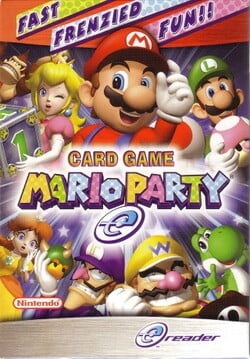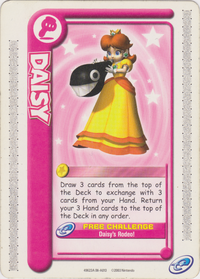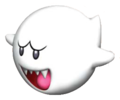Mario Party-e
It has been requested that more images be uploaded for this article. Remove this notice only after the additional images have been added. Specific(s): The cards, playboard, and anything else in this set
| Mario Party-e | |
|---|---|
 North American box art | |
| Developer | indieszero[1] |
| Publisher | Nintendo |
| Platform(s) | Game Boy Advance |
| Release date | Template:Release |
| Language(s) | English (United States) French (France) French (Canada) Spanish (Spain) Spanish (Latin America) |
| Genre | Party |
| Mode(s) | 2-4 players |
| Format | Game Boy Advance: |
| Input | Game Boy Advance:
|
Mario Party-e is a board game for the Game Boy Advance that uses the e-Reader accessory. It was released on February 17, 2003.[2] It comes with 64 cards, a playboard, and an instruction booklet. The game was only released in North America. The game makes use of artwork and characters from Mario Party 4.
Characters
Playable
- Mario (in Cast Away Mario!, Mario's Mallet, Bolt from Boo, Time Bomb Ticks!, and Waluigi's Reign)
- Yoshi (in Fast Feed Yoshi!)
- Wario (in Wario's Bluff, appears as the balloon in Balloon Burst!)
- Waluigi (in Time Bomb Ticks!, appears as an NPC in Waluigi's Reign)
- Princess Daisy (in Daisy's Rodeo)
Non-playable
- Luigi (appears in Mario's Mallet)
- Goomba (appears in Mario's Mallet)
- Donkey Kong (cameo on the game board)
- Bowser (appears in Spinister Bowser, appears as the mechanical bull in Daisy's Rodeo!)
- Big Boo (appears in Bolt from Boo)
- Princess Peach (appears in Cast Away Mario! and Mario's Mallet)
- Cheep Cheep (appears in Cast Away Mario!)
- Blurp (appears in Cast Away Mario!)
- Rip Van Fish (appears in Cast Away Mario!)
- Sidestepper (appears in Cast Away Mario!)
- Shy Guy (appears in Fast Feed Yoshi!)
- Lakitu (appears in Lakitu's Luck)
Player set-up
- If it is a 2-player game, players should use 58 cards and remove 2 each of the superstar item cards (Superstar's Shoes, Superstar's Clothes and Superstar's Hat) from the deck set.
- If it is a 3-player game, players should use 61 cards and remove 1 each of the Superstar's Item cards from the deck set.
- If it is a 4-player game, players use all 64 cards in the deck. To play more than 4 players, use a second set of cards and remove Superstar items depending on the number of players (i.e. If 6 player are going to play, players should use all 6 Superstar items to equal all the players). Players can also decide how many Item cards to play with.
Using the playboard
Each player in the game has 4 play areas on the playboard.
- Hand Cards The hand cards are cards that each player holds in their hands for themselves. The players can only hold 5 cards in the hand before and after their turn. The play may look at the player's cards, but the player can't look at the other players' cards.
On the playboard
- Deck Pad This is a set of faced-down cards that have not been played. Each player in the game draws a card from the deck at the beginning of their turn.
- Discard Pile The Discard Pile is a set of faced-up cards that have been played. Any player in the game can look at the set of used cards at anytime.
- In-Play Cards Each player in the game has these on the playboard. In-Play cards are cards that are placed face-up in front of each player. The In-Play Cards have either Coin cards or Superstar Item cards.
Using the Nintendo e-Reader
To get a full experience playing this game, the player must have a Nintendo e-Reader and a Game Boy Advance ready and must use it to scan e-Challenge cards to play one of 11 minigames to test the player's skills. However, the game can be either played with or without the e-Reader.
Gameplay
- First, players should shuffle the card set and distribute 5 cards to each player. The cards that the players' held are called Hand cards and can only seen by the players who had their Hand cards.
- Then, players place all the remaining cards face-down on the deck.
- The youngest player goes first and plays moves clockwise (from left to right).
A player's turn
- A player should draw a card from the deck pile.
- Then, the player should choose one card to Play or Discard in the Discard Pile. If the player plays a Coin or Item card, they should place it up on the In-Play Cards as the card is now In-Play. If the player plays any other card, they should place it face-up on the gameboard and follow the instructions on the card. When the instructions have been followed, the player should put the card on the Discard Pile face-up.
- The play continues clockwise until someone places a Superstar card In-Play to win the game.
Hand Card Rules
- Each player can only carry 5 cards on their hands before and after each turn. As of such, each player must draw a card form the deck and Play or Discard a card onto the Discard Pile face-up every turn.
- When the deck has no face-down cards, the player reshuffles the other cards on the Discard Pile and places it face-down to form a new deck.
Winning the Game
To win the game, the player must be the first to have the Superstar's Shoes, Superstar's Clothes and Superstar's Hat; after that the player also has to place the Superstar Card to win.
Card Types
- Coin Cards (24 total)
Some cards in the deck require Coin-cards to be In-Play before they can be used. The small coin icon on the card determines how many coins the player has to pay to use that card; if the Coin-cards are used, place it on the Discard Pile as the player uses the other card.
- Item Cards (12 total)
There are three types of Item cards: Superstar’s Shoes, Superstar’s Clothes and Superstar’s Hat. Each item card will cost 2 coins each to place it in the In-Card Play. Before playing an Item Card; the player must first place 2 coin-cards in the Discard Pile face up so the player can play the item card.
There are 3 types of item cards that must be in In-Play before a Superstar card can be played to win the game.
- Superstar Cards (4 total)
The player must use this card to win the game if the player places the 3 types of item cards in the In-Play. The card can be also used to take 1 item card from the rival’s In-play cards and place it on the player’s In-play cards.
- Blocker Cards (5 total)
This card can prevent an opponent from stealing the player’s In-Play or Hand Cards. All blocker cards require a coin to play this card.
NOTE: The Super Mario, Super Luigi and Donkey Kong Blocker cards had a special counter move. It is noted that it cost an additional coin-card to play that special move.
After playing this card, draw a card from the Deck Pile to maintain a Hand of 5 cards. This card can be discarded during the player’s turn without paying
- Search Cards (4 total)
This card allows the player to take some cards from the Deck or Discard Pile and exchange the cards with Hand cards. All search cards require a coin-card to play expect for the LAKITU card.
- Chaos Cards (10 total)
These chaotic cards can be used to take or exchange In-play or Hand Cards with other players in the game. The Yoshi card costs 2 coin-cards. If the player doesn’t have enough coin-cards to play, the player may play a Free-Challenge MiniGame on the e-Reader by using the card.
- Duel Cards (5 total)
The duel card can used to battle another player in the game in a Minigame (using an e-Reader and Game Boy Advance) for In-Play or Hand cards. The SUPER WARIO card and SUPER WALUIGI card may cost a coin-card to use that card. If the player doesn’t have an e-Reader, the duel can be decided by a coin toss to battle each other.
e-Challenge Cards (11 total)
These cards can allow the player to play a Minigame on a Game Boy Advance with an e-Reader. There are 3 types of e-Challenge Cards: Free Challenge Cards, Wonder Challenge cards and Duel Challenge cards.
- Free Challenge Cards (4 total)
These cards allow the player to take or exchange cards with another player, or from the Discard or Deck piles depend on what the player says. All cards require the player to pay coin cards to play. The player must first place the required coin-cards face-up on the Discard Pile and follow the instructions on the card. If the player didn’t had the required number of coin cards but would still like to play the card; the player can declare a “Free Challenge” and play the minigame found on the e-Reader. The player needs a Game Boy Advance and an e-Reader to play the minigame. If the player wins the minigame, the player can play the following the instructions on the card. If you lose the Minigame, the player attempts to discard the card without using the effect of the card.
NOTE: If the player has enough In-Play Coin cards they must use the coin cards and cannot play the e-Reader Free Challenge.
- Wonder Challenge Cards (2 total)
The card gives the player the opportunity to play roulette with the Game Boy Advance and the e-Reader and take the chance on the outcome. Scan the card with the e-Reader and follow the instructions to play the minigame.
If the player doesn’t have the e-Reader, play the card following the instructions on the card to use it.
- Duel Challenge Cards (5 total)
These cards can be used to battle another player for In-Play or Hand Cards. The player using the Duel card can select any player in the game to duel.
NOTE: The Super Wario and Super Waluigi cards cost coin cards to play. The challenger must first place the required number of coin cards face-up on the Discard Pile. By then, the player must follow the instructions on the card after completing the duel.
If no player has an e-Reader, the duel can be decided by a coin toss. The player using a Duel card may select a player to duel. The player attempts to toss the coin in the air and the other player will call heads or tails. The side facing up when the coin lands; will determine the winner of the duel. By then, follow the instructions on the card.
Minigames
Free Challenge Minigames
Wonder Challenge Minigames
Duel Challenge Minigames
Staff
- Main article: List of Mario Party-e staff
Reception
Reviews of the card game are decently positive. IGN's Craig Harris rated the game 8.0, saying that the game is "easy to pick up and play", while suggesting that if Nintendo made booster packs that maximize the fun by adding more challenges, and utilizing the e-Reader, it would be a welcome addition. [3]
Gallery
Artwork
Cards
Rare GamePro Magazine Promotional Card
Game board
Sprites
Box art
Media
- For a complete list of media for this subject, see List of Mario Party-e media.
| File info 0:30 |
| File info 0:20 |
| File info 0:04 |
| File info 0:30 |
Trivia
- This is the only video game in which Daisy is playable and Peach is not playable. It is also the only Mario Party game where Luigi is not playable, making Mario and Yoshi the only two playable characters to be playable in every Mario Party game.
- This is also the final game to use Daisy's original design that first appeared in Super Mario Land, as her redesign from Mario Party 4 onwards would become the standard for appearances after this game.
- This is the only Mario Party game that is absent from the "history" section of the official Mario Portal website.[4]
External links
Notes
a - Mario Party-e can be played without the e-Reader accessory, but the accessory is required to play any of the 11 minigames.
References
- ^ "Mario Party-e(北米地域のみ)" (in Japanese). indieszero. Archived from the original on March 27, 2023. Retrieved June 5, 2023.
- ^ Cite error: Invalid
<ref>tag; no text was provided for refs namedrelease - ^ Harris, Craig (February 25, 2003). "Mario Party-e Review". IGN. Archived from the original on May 6, 2004. Retrieved June 5, 2023.
- ^ History. Mario Portal website.

























